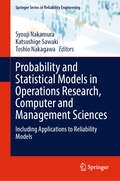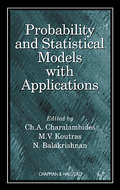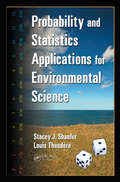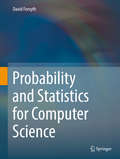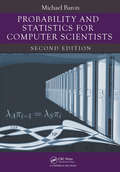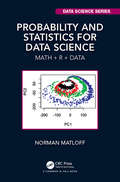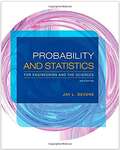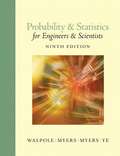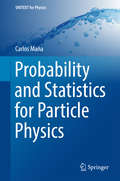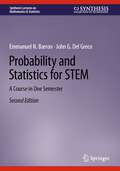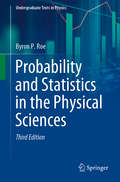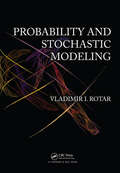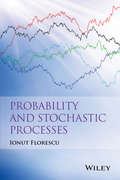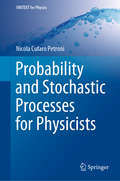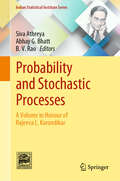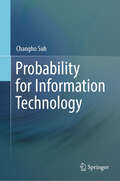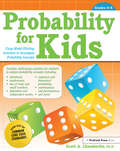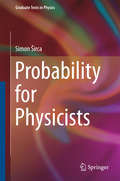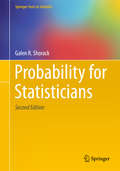- Table View
- List View
Probability and Statistical Models in Operations Research, Computer and Management Sciences: Including Applications to Reliability Models (Springer Series in Reliability Engineering)
by Toshio Nakagawa Syouji Nakamura Katsushige SawakiThis book explores the convergence of stochastic modeling, reliability tools, and the quest for solutions in an era of globalized challenges. The tools have become only more important in the unforeseen emergencies such as the COVID-19 pandemic and the conflict in Ukraine. This comprehensive book is an invaluable resource for graduate students seeking practical knowledge on probability and statistics in real-world applications. The book is divided into four parts: reliability, computer science, management science, and operations research. Each part includes surveys, recent results, and tools used. Moreover, it offers an essential reference point for researchers, engineers, and managers operating in laboratories, industries, businesses, and government agencies. Through the exchange of academic achievements, ideas, and discussions, this book serves as a catalyst for progress and innovation.
Probability and Statistical Models with Applications
by Ch. A. CharalambidesThis monograph of carefully collected articles reviews recent developments in theoretical and applied statistical science, highlights current noteworthy results and illustrates their applications; and points out possible new directions to pursue. With its enlightening account of statistical discoveries and its numerous figures and tables, Probabili
Probability and Statistics Applications for Environmental Science
by Louis Theodore Stacey J ShaeferSimple, clear, and to the point, Probability and Statistics Applications for Environmental Science delineates the fundamentals of statistics, imparting a basic understanding of the theory and mechanics of the calculations. User-friendliness, uncomplicated explanations, and coverage of example applications in the environmental field set this book ap
Probability and Statistics by Example: Volume 1, Basic Probability and Statistics
by Mark Kelbert Yuri SuhovBecause probability and statistics are as much about intuition and problem solving, as they are about theorem proving, students can find it very difficult to make a successful transition from lectures to examinations and practice. Since the subject is critical in many modern applications, Yuri Suhov and Michael Kelbert have rectified deficiencies in traditional lecture-based methods, by combining a wealth of exercises for which they have supplied complete solutions. These solutions are adapted to needs and skills of students and include basic mathematical facts as needed.
Probability and Statistics for Computer Science
by David ForsythThis textbook is aimed at computer science undergraduates late in sophomore or early in junior year, supplying a comprehensive background in qualitative and quantitative data analysis, probability, random variables, and statistical methods, including machine learning. With careful treatment of topics that fill the curricular needs for the course, Probability and Statistics for Computer Science features: * A treatment of random variables and expectations dealing primarily with the discrete case. * A practical treatment of simulation, showing how many interesting probabilities and expectations can be extracted, with particular emphasis on Markov chains. * A clear but crisp account of simple point inference strategies (maximum likelihood; Bayesian inference) in simple contexts. This is extended to cover some confidence intervals, samples and populations for random sampling with replacement, and the simplest hypothesis testing. * A chapter dealing with classification, explaining why it's useful; how to train SVM classifiers with stochastic gradient descent; and how to use implementations of more advanced methods such as random forests and nearest neighbors. * A chapter dealing with regression, explaining how to set up, use and understand linear regression and nearest neighbors regression in practical problems. * A chapter dealing with principal components analysis, developing intuition carefully, and including numerous practical examples. There is a brief description of multivariate scaling via principal coordinate analysis. * A chapter dealing with clustering via agglomerative methods and k-means, showing how to build vector quantized features for complex signals. Illustrated throughout, each main chapter includes many worked examples and other pedagogical elements such as boxed Procedures, Definitions, Useful Facts, and Remember This (short tips). Problems and Programming Exercises are at the end of each chapter, with a summary of what the reader should know. Instructor resources include a full set of model solutions for all problems, and an Instructor's Manual with accompanying presentation slides.
Probability and Statistics for Computer Scientists
by Michael BaronStudent-Friendly Coverage of Probability, Statistical Methods, Simulation, and Modeling ToolsIncorporating feedback from instructors and researchers who used the previous edition, Probability and Statistics for Computer Scientists, Second Edition helps students understand general methods of stochastic modeling, simulation, and data analysis; make o
Probability and Statistics for Computer Scientists, Third Edition
by Michael BaronPraise for the Second Edition: "The author has done his homework on the statistical tools needed for the particular challenges computer scientists encounter... [He] has taken great care to select examples that are interesting and practical for computer scientists. ... The content is illustrated with numerous figures, and concludes with appendices and an index. The book is erudite and … could work well as a required text for an advanced undergraduate or graduate course." ---Computing Reviews Probability and Statistics for Computer Scientists, Third Edition helps students understand fundamental concepts of Probability and Statistics, general methods of stochastic modeling, simulation, queuing, and statistical data analysis; make optimal decisions under uncertainty; model and evaluate computer systems; and prepare for advanced probability-based courses. Written in a lively style with simple language and now including R as well as MATLAB, this classroom-tested book can be used for one- or two-semester courses. Features: Axiomatic introduction of probability Expanded coverage of statistical inference and data analysis, including estimation and testing, Bayesian approach, multivariate regression, chi-square tests for independence and goodness of fit, nonparametric statistics, and bootstrap Numerous motivating examples and exercises including computer projects Fully annotated R codes in parallel to MATLAB Applications in computer science, software engineering, telecommunications, and related areas In-Depth yet Accessible Treatment of Computer Science-Related TopicsStarting with the fundamentals of probability, the text takes students through topics heavily featured in modern computer science, computer engineering, software engineering, and associated fields, such as computer simulations, Monte Carlo methods, stochastic processes, Markov chains, queuing theory, statistical inference, and regression. It also meets the requirements of the Accreditation Board for Engineering and Technology (ABET). About the Author Michael Baron is David Carroll Professor of Mathematics and Statistics at American University in Washington D. C. He conducts research in sequential analysis and optimal stopping, change-point detection, Bayesian inference, and applications of statistics in epidemiology, clinical trials, semiconductor manufacturing, and other fields. M. Baron is a Fellow of the American Statistical Association and a recipient of the Abraham Wald Prize for the best paper in Sequential Analysis and the Regents Outstanding Teaching Award. M. Baron holds a Ph.D. in statistics from the University of Maryland. In his turn, he supervised twelve doctoral students, mostly employed on academic and research positions.
Probability and Statistics for Data Science: Math + R + Data (Chapman & Hall/CRC Data Science Series)
by Norman MatloffProbability and Statistics for Data Science: Math + R + Data covers "math stat"—distributions, expected value, estimation etc.—but takes the phrase "Data Science" in the title quite seriously: <P><P> * Real datasets are used extensively. * All data analysis is supported by R coding. * Includes many Data Science applications, such as PCA, mixture distributions, random graph models, Hidden Markov models, linear and logistic regression, and neural networks. * Leads the student to think critically about the "how" and "why" of statistics, and to "see the big picture." * Not "theorem/proof"-oriented, but concepts and models are stated in a mathematically precise manner. <P><P> Prerequisites are calculus, some matrix algebra, and some experience in programming. <P><P> Norman Matloff is a professor of computer science at the University of California, Davis, and was formerly a statistics professor there. He is on the editorial boards of the Journal of Statistical Software and The R Journal. His book Statistical Regression and Classification: From Linear Models to Machine Learning was the recipient of the Ziegel Award for the best book reviewed in Technometrics in 2017. He is a recipient of his university's Distinguished Teaching Award.
Probability and Statistics for Engineering and the Sciences
by Jay L. DevorePut statistical theories into practice with PROBABILITY AND STATISTICS FOR ENGINEERING AND THE SCIENCES, 9th Edition. Always a favorite with statistics students, this calculus-based text offers a comprehensive introduction to probability and statistics while demonstrating how professionals apply concepts, models, and methodologies in today's engineering and scientific careers. <p><p>Jay Devore, an award-winning professor and internationally recognized author and statistician, emphasizes authentic problem scenarios in a multitude of examples and exercises, many of which involve real data, to show how statistics makes sense of the world. Mathematical development and derivations are kept to a minimum. <p><p>The book also includes output, graphics, and screen shots from various statistical software packages to give you a solid perspective of statistics in action. A Student Solutions Manual, which includes worked-out solutions to almost all the odd-numbered exercises in the book, is available.
Probability and Statistics for Engineering and the Sciences with Modeling using R (Textbooks in Mathematics)
by Rodney X. Sturdivant William P. FoxProbability and statistics courses are more popular than ever. Regardless of your major or your profession, you will most likely use concepts from probability and statistics often in your career. The primary goal behind this book is offering the flexibility for instructors to build most undergraduate courses upon it. This book is designed for either a one-semester course in either introductory probability and statistics (not calculus-based) and/or a one-semester course in a calculus-based probability and statistics course. The book focuses on engineering examples and applications, while also including social sciences and more examples. Depending on the chapter flows, a course can be tailored for students at all levels and background. Over many years of teaching this course, the authors created problems based on real data, student projects, and labs. Students have suggested these enhance their experience and learning. The authors hope to share projects and labs with other instructors and students to make the course more interesting for both. R is an excellent platform to use. This book uses R with real data sets. The labs can be used for group work, in class, or for self-directed study. These project labs have been class-tested for many years with good results and encourage students to apply the key concepts and use of technology to analyze and present results.
Probability and Statistics for Engineers and Scientists (Ninth Edition)
by Raymond H. Myers Ronald E. Walpole Sharon L. Myers Keying E. YeThis classic text provides a rigorous introduction to basic probability theory and statistical inference, with a unique balance of theory and methodology. Interesting, relevant applications use real data from actual studies, showing how the concepts and methods can be used to solve problems in the field. This revision focuses on improved clarity and deeper understanding.
Probability and Statistics for Machine Learning: A Textbook
by Charu C. AggarwalThis book covers probability and statistics from the machine learning perspective. The chapters of this book belong to three categories: 1. The basics of probability and statistics: These chapters focus on the basics of probability and statistics, and cover the key principles of these topics. Chapter 1 provides an overview of the area of probability and statistics as well as its relationship to machine learning. The fundamentals of probability and statistics are covered in Chapters 2 through 5. 2. From probability to machine learning: Many machine learning applications are addressed using probabilistic models, whose parameters are then learned in a data-driven manner. Chapters 6 through 9 explore how different models from probability and statistics are applied to machine learning. Perhaps the most important tool that bridges the gap from data to probability is maximum-likelihood estimation, which is a foundational concept from the perspective of machine learning. This concept is explored repeatedly in these chapters. 3. Advanced topics: Chapter 10 is devoted to discrete-state Markov processes. It explores the application of probability and statistics to a temporal and sequential setting, although the applications extend to more complex settings such as graphical data. Chapter 11 covers a number of probabilistic inequalities and approximations. The style of writing promotes the learning of probability and statistics simultaneously with a probabilistic perspective on the modeling of machine learning applications. The book contains over 200 worked examples in order to elucidate key concepts. Exercises are included both within the text of the chapters and at the end of the chapters. The book is written for a broad audience, including graduate students, researchers, and practitioners.
Probability and Statistics for Particle Physics
by Carlos MañaThis book comprehensively presents the basic concepts of probability and Bayesian inference with sufficient generality to make them applicable to current problems in scientific research. The first chapter provides the fundamentals of probability theory that are essential for the analysis of random phenomena. The second chapter includes a full and pragmatic review of the Bayesian methods that constitute a natural and coherent framework with enough freedom to analyze all the information available from experimental data in a conceptually simple manner. The third chapter presents the basic Monte Carlo techniques used in scientific research, allowing a large variety of problems to be handled difficult to tackle by other procedures. The author also introduces a basic algorithm, which enables readers to simulate samples from simple distribution, and describes useful cases for researchers in particle physics.The final chapter is devoted to the basic ideas of Information Theory, which are important in the Bayesian methodology. This highly readable book is appropriate for graduate-level courses, while at the same time being useful for scientific researches in general and for physicists in particular since most of the examples are from the field of Particle Physics.
Probability and Statistics for STEM: A Course in One Semester (Synthesis Lectures on Mathematics & Statistics)
by Emmanuel N. Barron John G. Del GrecoThis new edition presents the essential topics in probability and statistics from a rigorous standpoint. Any discipline involving randomness, including medicine, engineering, and any area of scientific research, must have a way of analyzing or even predicting the outcomes of an experiment. The authors focus on the tools for doing so in a thorough, yet introductory way. After providing an overview of the basics of probability, the authors cover essential topics such as confidence intervals, hypothesis testing, and linear regression. These subjects are presented in a one semester format, suitable for engineers, scientists, and STEM students with a solid understanding of calculus. There are problems and exercises included in each chapter allowing readers to practice the applications of the concepts.
Probability and Statistics in the Physical Sciences (Undergraduate Texts in Physics)
by Byron P. RoeThis book, now in its third edition, offers a practical guide to the use of probability and statistics in experimental physics that is of value for both advanced undergraduates and graduate students. Focusing on applications and theorems and techniques actually used in experimental research, it includes worked problems with solutions, as well as homework exercises to aid understanding. Suitable for readers with no prior knowledge of statistical techniques, the book comprehensively discusses the topic and features a number of interesting and amusing applications that are often neglected. Providing an introduction to neural net techniques that encompasses deep learning, adversarial neural networks, and boosted decision trees, this new edition includes updated chapters with, for example, additions relating to generating and characteristic functions, Bayes’ theorem, the Feldman-Cousins method, Lagrange multipliers for constraints, estimation of likelihood ratios, and unfolding problems.
Probability and Stochastic Modeling
by Vladimir I. RotarA First Course in Probability with an Emphasis on Stochastic ModelingProbability and Stochastic Modeling not only covers all the topics found in a traditional introductory probability course, but also emphasizes stochastic modeling, including Markov chains, birth-death processes, and reliability models. Unlike most undergraduate-level probability t
Probability and Stochastic Processes
by Ionut FlorescuA comprehensive and accessible presentation of probability and stochastic processes with emphasis on key theoretical concepts and real-world applicationsWith a sophisticated approach, Probability and Stochastic Processes successfully balances theory and applications in a pedagogical and accessible format. The book's primary focus is on key theoretical notions in probability to provide a foundation for understanding concepts and examples related to stochastic processes.Organized into two main sections, the book begins by developing probability theory with topical coverage on probability measure; random variables; integration theory; product spaces, conditional distribution, and conditional expectations; and limit theorems. The second part explores stochastic processes and related concepts including the Poisson process, renewal processes, Markov chains, semi-Markov processes, martingales, and Brownian motion. Featuring a logical combination of traditional and complex theories as well as practices, Probability and Stochastic Processes also includes:Multiple examples from disciplines such as business, mathematical finance, and engineeringChapter-by-chapter exercises and examples to allow readers to test their comprehension of the presented materialA rigorous treatment of all probability and stochastic processes conceptsAn appropriate textbook for probability and stochastic processes courses at the upper-undergraduate and graduate level in mathematics, business, and electrical engineering, Probability and Stochastic Processes is also an ideal reference for researchers and practitioners in the fields of mathematics, engineering, and finance.
Probability and Stochastic Processes for Physicists (UNITEXT for Physics)
by Nicola Cufaro PetroniThis book seeks to bridge the gap between the parlance, the models, and even the notations used by physicists and those used by mathematicians when it comes to the topic of probability and stochastic processes. The opening four chapters elucidate the basic concepts of probability, including probability spaces and measures, random variables, and limit theorems. Here, the focus is mainly on models and ideas rather than the mathematical tools. The discussion of limit theorems serves as a gateway to extensive coverage of the theory of stochastic processes, including, for example, stationarity and ergodicity, Poisson and Wiener processes and their trajectories, other Markov processes, jump-diffusion processes, stochastic calculus, and stochastic differential equations. All these conceptual tools then converge in a dynamical theory of Brownian motion that compares the Einstein–Smoluchowski and Ornstein–Uhlenbeck approaches, highlighting the most important ideas that finally led to a connection between the Schrödinger equation and diffusion processes along the lines of Nelson’s stochastic mechanics. A series of appendices cover particular details and calculations, and offer concise treatments of particular thought-provoking topics.
Probability and Stochastic Processes: A Volume in Honour of Rajeeva L. Karandikar (Indian Statistical Institute Series)
by B. V. Rao Siva Athreya Abhay G. BhattThe book collects papers on several topics in probability and stochastic processes. These papers have been presented at a conference organised in honour of Professor Rajeeva L. Karandikar who turned 65 in 2021. He was a distinguished researcher and a teacher at the Indian Statistical Institute (ISI), Delhi Centre, for many years. He has been a multi-faceted academician, interacting with the Government of India and the industry. He has left an indelible mark in every endeavour of his and in his several different avatars—be it in the ISI, in the industry or as Director of Chennai Mathematical Institute. This book will be useful to senior undergraduate and graduate students, as well as researchers in probability, statistics and related fields.
Probability for Finance
by Tomasz Zastawniak Ekkehard Kopp Jan MalczakStudents and instructors alike will benefit from this rigorous, unfussy text, which keeps a clear focus on the basic probabilistic concepts required for an understanding of financial market models, including independence and conditioning. Assuming only some calculus and linear algebra, the text develops key results of measure and integration, which are applied to probability spaces and random variables, culminating in central limit theory. Consequently it provides essential prerequisites to graduate-level study of modern finance and, more generally, to the study of stochastic processes. Results are proved carefully and the key concepts are motivated by concrete examples drawn from financial market models. Students can test their understanding through the large number of exercises and worked examples that are integral to the text.
Probability for Information Technology
by Changho SuhThis book introduces probabilistic modelling and explores its role in solving a broad spectrum of engineering problems that arise in Information Technology (IT). Divided into three parts, it begins by laying the foundation of basic probability concepts such as sample space, events, conditional probability, independence, total probability law and random variables. The second part delves into more advanced topics including random processes and key principles like Maximum A Posteriori (MAP) estimation, the law of large numbers and the central limit theorem. The last part applies these principles to various IT domains like communication, social networks, speech recognition, and machine learning, emphasizing the practical aspect of probability through real-world examples, case studies, and Python coding exercises. A notable feature of this book is its narrative style, seamlessly weaving together probability theories with both classical and contemporary IT applications. Each concept is reinforced with tightly-coupled exercise sets, and the associated fundamentals are explored mostly from first principles. Furthermore, it includes programming implementations of illustrative examples and algorithms, complemented by a brief Python tutorial. Departing from traditional organization, the book adopts a lecture-notes format, presenting interconnected themes and storylines. Primarily tailored for sophomore-level undergraduates, it also suits junior and senior-level courses. While readers benefit from mathematical maturity and programming exposure, supplementary materials and exercise problems aid understanding. Part III serves to inspire and provide insights for students and professionals alike, underscoring the pragmatic relevance of probabilistic concepts in IT.
Probability for Kids: Using Model-Eliciting Activities to Investigate Probability Concepts (Grades 4-6)
by Scott ChamberlinProbability for Kids features real-world probability scenarios for students in grades 4-6. Students will encounter problems in which they read about students their age selling magazines for a school fund raiser, concerned about their homeroom assignments, and trying to decode the combination to a safe that their grandfather abandoned, among others, all of which maximizes learning so students gain a deep understanding of concepts in probability. This book will help teachers, parents, and other educators to employ best practices in implementing challenging math activities based on standards. Problem solvers who complete all six activities in the book will understand the six basic principles of probability and be high school ready for discussions in probability. Grades 4-6
Probability for Physicists
by Simon SircaThis book is designed as a practical and intuitive introduction to probability, statistics and random quantities for physicists. The book aims at getting to the main points by a clear, hands-on exposition supported by well-illustrated and worked-out examples. A strong focus on applications in physics and other natural sciences is maintained throughout. In addition to basic concepts of random variables, distributions, expected values and statistics, the book discusses the notions of entropy, Markov processes, and fundamentals of random number generation and Monte-Carlo methods.
Probability for Statisticians
by Galen R. ShorackThe choice of examples used in this text clearly illustrate its use for a one-year graduate course. The material to be presented in the classroom constitutes a little more than half the text, while the rest of the text provides background, offers different routes that could be pursued in the classroom, as well as additional material that is appropriate for self-study. Of particular interest is a presentation of the major central limit theorems via Steins method either prior to or alternative to a characteristic function presentation. Additionally, there is considerable emphasis placed on the quantile function as well as the distribution function, with both the bootstrap and trimming presented. The section on martingales covers censored data martingales.
Probability for Statistics and Machine Learning
by Anirban DasguptaThis book provides a versatile and lucid treatment of classic as well as modern probability theory, while integrating them with core topics in statistical theory and also some key tools in machine learning. It is written in an extremely accessible style, with elaborate motivating discussions and numerous worked out examples and exercises. The book has 20 chapters on a wide range of topics, 423 worked out examples, and 808 exercises. It is unique in its unification of probability and statistics, its coverage and its superb exercise sets, detailed bibliography, and in its substantive treatment of many topics of current importance. This book can be used as a text for a year long graduate course in statistics, computer science, or mathematics, for self-study, and as an invaluable research reference on probabiliity and its applications. Particularly worth mentioning are the treatments of distribution theory, asymptotics, simulation and Markov Chain Monte Carlo, Markov chains and martingales, Gaussian processes, VC theory, probability metrics, large deviations, bootstrap, the EM algorithm, confidence intervals, maximum likelihood and Bayes estimates, exponential families, kernels, and Hilbert spaces, and a self contained complete review of univariate probability.
